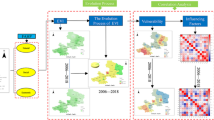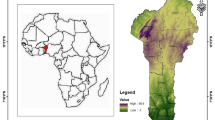Abstract
The Turpan Oasis is a typical fragile environment that lies in an arid region of eastern Xinjiang and is affected by natural conditions and human activities. The severity of the land degradation and desertification in this area is increasing; therefore, ecological vulnerability evaluations are important for environmental management of the region. In this study, theories and methods of evaluating ecological vulnerability and the typical characteristics of ecological vulnerability were summarized. By combining the environmental characteristics of the research area and the driving factors of ecological vulnerability, a multilayer vulnerability evaluation index system was built, and a pressure-state-response model was established to evaluate the ecological vulnerability. GIS and remote sensing technologies were applied to extract each index and create a spatial distribution map of vulnerability. The results showed that the vulnerability index values ranged from 3.08 to 6.59, with an average value of 5.19. Regions with moderate vulnerability accounted for 81.85 % of the total area, whereas regions with light and serious vulnerability accounted for 4.19 and 13.95 % of the total area, respectively. Thus, more than 80 % of the area had moderate vulnerability, and nearly 14 % of the area had serious vulnerability. The degree of vulnerability increased from east to west, and the ecological vulnerability in the inner oasis was significantly lower than that in the outer oasis. The key factors for ecological restoration and reconstruction are to control desertification and to ensure ecological water use to the greatest extent.





Similar content being viewed by others
References
Antonio GS, Juan-Alfonso B, Nicolau J (2003) Assessing landscape values: a proposal for a multidimensional conceptual model. Ecol Model 168:319–341. doi:10.1016/S0304-3800(03)00144-3
Aryafar A, Yousefi S, Ardejani FD (2013) The weight of interaction of mining activities: groundwater in environmental impact assessment using fuzzy analytical hierarchy process (FAHP). Environ Earth Sci 68(8):2313–2324. doi:10.1007/s12665-012-1910-x
Aspinall R, Pearson D (2000) Integrated geographical assessment of environmental condition in water catchments: linking landscape ecology, environmental modeling and GIS. J Environ Manage 59(4):299–329. doi:10.1006/jema.2000.0372
Babiker IS, Mohamed MA, Hiyama T, Kato K (2005) A GIS-based DRASTIC model for assessing aquifer vulnerability in Kakamigahara Heights, Gifu Prefecture, central Japan. Sci Total Environ 345(1):127–140. doi:10.1016/j.scitotenv.2004.11.005
Bagdanavičiūtė I, Valiūnas J (2013) GIS-based land suitability analysis integrating multi-criteria evaluation for the allocation of potential pollution sources. Environ Earth Sci 68(6):1797–1812. doi:10.1007/s12665-012-1869-7
Benjamin MT, Daniel OC, Dimas MF (2013) Financial fragility in a general equilibrium model: the Brazilian case. Ann Finance 9(3):519–541. doi:10.1007/s10436-012-0199-9
Bi CJ, Chen ZL, Wang J, Zhou D (2013) Quantitative assessment of soil health under different planting patterns and soil types. Pedosphere 23(2):194–204
Chatterjee S, Krishna AP, Sharma AP (2014) Geospatial assessment of soil erosion vulnerability at watershed level in some sections of the Upper Subarnarekha river basin, Jharkhand, India. Environ Earth Sci 71(1):357–374. doi:10.1007/s12665-013-2439-3
Duguy B, Alloza JA, Baeza MJ, De la Riva J, Echeverría M, Ibarra P, Llovet J, Cabello FP, Rovira P, Vallejo RV (2012) Modelling the ecological vulnerability to forest fires in mediterranean ecosystems using geographic information technologies. Environ Manage 50(6):1012–1026. doi:10.1007/s00267-012-9933-3
Dzeroski S (2001) Applications of symbolic machine learning to ecological. Ecol Model 146:263–273. doi:10.1016/S0304-3800(01)00312-X
Fang SF, Pei H, Beven KJ, Liu ZH, Wei ZC (2010) Water resources assessment and regional virtual water potential in Turpan basin, China. Water Resour Manag 24(13):3321–3332. doi:10.1007/s11269-010-9608-x
Farshad R, Safavi HR, Ahmad AI (2013) Groundwater vulnerability assessment using fuzzy logic: a case study in the Zayandehrood Aquifers, Iran. Environ Manage 51(1):267–277. doi:10.1007/s00267-012-9960-0
Fuchs S, Birkmann J, Glade T (2012) Vulnerability assessment in natural hazard and risk analysis: current approaches and future challenges. Nat Hazards 64(3):169–1975. doi:10.1007/s11069-012-0352-9
Gao C, Lei J, Jin FJ (2013) The classification and assessment of vulnerability of man-land system of oasis city in arid area. Front Earth Sci 7(4):406–416. doi:10.1007/s11707-013-0402-y
Gonzalez P, Neilson RP, Lenihan JM, Drapek RJ (2010) Global patterns in the vulnerability of ecosystems to vegetation shifts due to climate change. Global Ecol Biogeogr 19(6):755–768. doi:10.1111/j.1466-8238.2010.00558.x
Hoegh-Guldberg O, Bruno JF (2010) The impact of climate change on the world’s marine ecosystems. Science 328(5985):1523–1528
Huang PH, Tsai JS, Lin WT (2010) Using multiple-criteria decision-making techniques for eco-environmental vulnerability assessment: a case study on the Chi-Jia-Wan Stream watershed Taiwan. Environ Monit Assess 168(1):141–158. doi:10.1007/s10661-009-1098-z
Hufschmidt G (2011) A comparative analysis of several vulnerability concepts. Nat Hazards 58(2):621–643. doi:10.1007/s11069-011-9823-7
Ippolito AS, Sala JH, Faber MV (2010) Ecological vulnerability analysis: a river basin case study. Sci Total Environ 408(18):3880–3890. doi:10.1016/j.scitotenv.2009.10.002
Kangas J, Store R, Leskinen P, Mehtätalo L (2000) Improving the quality of landscape ecological forest planning by utilizing advanced decision-support tools. For Ecol Manag 132(2):157–171. doi:10.1016/S0378-1127(99)00221-2
Khan S (2012) Vulnerability assessments and their planning implications: a case study of the Hutt Valley, New Zealand. Nat Hazards 64(2):1587–1607. doi:10.1007/s11069-012-0327-x
Kia MB, Pirasteh S, Pradhan B, Mahmud AR, Sulaiman WA, Moradi A (2012) An artificial neural network model for flood simulation using GIS: Johor River Basin, Malaysia. Environ Earth Sci 67(1):251–264. doi:10.1007/s12665-011-1504-z
Lashkari A, Bannayan M (2012) Agrometeorological study of crop drought vulnerability and avoidance in northeast of Iran. Theor Appl Climatol 109(2):27–38. doi:10.1007/s00704-012-0769-9
Li A, Wang A, Liang S, Zhou W (2006) Eco-environmental vulnerability evaluation in mountainous region using remote sensing and GIS-A case study in the upper reaches of Minjiang River, China. Ecol Model 192:175–187. doi:10.1016/j.ccolmodel.2005.07.005
Li RQ, Dong M, Cui JY, Zhang LL, Cui GQ, He WM (2007) Quantification of the impact of land use and land cover changes on ecosystem services: a case study in Pingbian County, China. Environ Monit Assess 128(1):503–510. doi:10.1007/s10661-006-9344-0
Manfre LA, da Silva AM, Urban RC, Rodgers J (2013) Environmental fragility evaluation and guidelines for environmental zoning: a study case on Ibiuna (the Southeastern Brazilian region). Environ Earth Sci 69(3):947–957. doi:10.1007/s12665-012-1979-2
Mao XY, Meng JJ, Xiang YY (2013) Cellular automata-based model for developing land use ecological security patterns in semi-arid areas: a case study of Ordos, Inner Mongolia, China. Environ Earth Sci 70(1):269–279. doi:10.1007/s12665-012-2125-x
Moreno A, Becken S (2009) A climate change vulnerability assessment methodology for coastal tourism. J Sustain Tour 17(4):473–488. doi:10.1080/09669580802651681
Ramezani H, Holm S (2011) Sample based estimation of landscape metrics; accuracy of line intersect sampling for estimating edge density and Shannon’s diversity index. Environ Ecol Stat 18(1):109–130. doi:10.1007/s10651-009-0123-2
Saidi S, Bouri S, Dhia HB (2010) Groundwater vulnerability and risk mapping of the Hajeb-jelma aquifer (Central Tunisia) using a GIS-based DRASTIC model. Environ Earth Sci 59(7):1579–1588. doi:10.1007/s12665-009-0143-0
Salvati L, Tombolini I, Perini L, Ferrara A (2013) Landscape changes and environmental quality: the evolution of land vulnerability and potential resilience to degradation in Italy. Reg Environ Change 13(6):1223–1233. doi:10.1007/s10113-013-0437-3
Santos CF, Carvalho R, Andrade F (2013) Quantitative assessment of the differential coastal vulnerability associated to oil spills. J Coast Conserv 17(1):25–36. doi:10.1007/s11852-012-0215-2
Scheuer S, Haase D, Meyer V (2011) Exploring multicriteria flood vulnerability by integrating economic, social and ecological dimensions of flood risk and coping capacity: from a starting point view towards an end point view of vulnerability. Nat Hazards 58(2):731–751. doi:10.1007/s11069-010-9666-7
Shao HY, Liu M, Shao QF, Sun XF, Wu JH, Xiang ZY, Yang WN (2014) Research on eco-environmental vulnerability evaluation of the Anning River Basin in the upper reaches of the Yangtze River. Environ Earth Sci 72(5):1555–1568. doi:10.1007/s12665-014-3060-9
Shi Q, Lu ZH, Liu ZM, Miao Y, Xia MJ (2007) Evaluation model of the grey fuzzy on eco-environment vulnerability. J For Res-Jpn 18(3):187–192. doi:10.1007/s11676-007-0038-4
Shi HD, Gao QX, Qi YQ, Liu JY, Hu YF (2010) Wind erosion hazard assessment of the Mongolian Plateau using FCM and GIS techniques. Environ Earth Sci 61:689–697. doi:10.1007/s12665-009-0381-1
Song GB, Chen Y, Tian MR (2010) The ecological vulnerability evaluation in southwestern mountain region of China based on GIS and AHP method. Pro Environ Sci 2:465–475. doi:10.1016/j.proenv.2010.10.051
Sullivan C (2011) Quantifying water vulnerability: a multi-dimensional approach. Stoch Env Res Risk 25(4):627–640. doi:10.1007/s00477-010-0426-8
Tasser E, Sternbach E, Tappeiner U (2008) Biodiversity indicators for sustainability monitoring at municipality level: an example of implementation in an alpine region. Ecol Indic 8(3):204–223. doi:10.1016/j.ecolind.2007.01.005
Walz U (2015) Indicators to monitor the structural diversity of landscapes. Ecol Model 295:88–106. doi:10.1016/j.ecolmodel.2014.07.011
Walz U, Syrbe RU (2013) Linking landscape structure and biodiversity. Ecol Indic 31:1–5. doi:10.1016/j.ecolind.2013.01.032
Wan L, Xia J, Hong S, Bu HM, Ning LK, Chen JX (2014) Decadal climate variability and vulnerability of water resources in arid regions of Northwest China. Environ Earth Sci. doi:10.1007/s12665-014-3874-5
Wang SY, Liu JS, Yang CJ (2008) Eco-environmental vulnerability evaluation in the Yellow River Basin, China. Pedosphere 18(2):171–182. doi:10.1016/S1002-0160(08)60005-3
Watts MJ, Bohle HG (1993) The space of vulnerability: the causal structure of hunger and famine. Prog Hum Geogr 17:43–47. doi:10.1177/030913259301700103
Wu B, Ci LJ (2002) Landscape change and desertification development in Mu Us Sandland, Northern China. J Arid Environ 50(3):429–444. doi:10.1006/jare.2001.0847
Wu J, Hobbs R (2002) Key issues and research priorities in landscape ecology: an idiosyncratic synthesis. Landsc Ecol 17(4):355–365. doi:10.1023/A:1020561630963
Yoo G, Hwang JH, Choi C (2011) Development and application of a methodology for vulnerability assessment of climate change in coastal cities. Ocean Coast Manage 54(7):524–534. doi:10.1016/j.ocecoaman.2011.04.001
Zhou XL, Yan Y, Wang H, Wu LY, Ren JZ (2011) Assessment of eco-environment vulnerability in the northeastern margin of the Qinghai-Tibetan Plateau, China. Environ Earth Sci 63(4):667–674. doi:10.1007/s12665-010-0731-z
Zou XP, Pang YX, Zhu HL (2013) The study between shadow banking and financial fragility in China: an empirical analysis based on the co-integration test and error correction model. Qual Quant 47(6):3363–3370. doi:10.1007/s11135-012-9725-0
Acknowledgments
The authors thank all the team members’ wholehearted participation in this work, and also are grateful to anonymous referees and associate editors for their thoughtful suggestions on the manuscript, which has led to improvements in this paper. This study was supported and funded by the “National Basic Research Program of China (973 Program) (grant no 2010CB951504)”, the “Natural Science Foundation of Hebei Province (grant no D2014203218), the “Yong Teacher’s Independent Research Project of Yanshan University (grant no 14LGA011), and the “National Natural Science Foundation of China (grant no 41201097)”.
Author information
Authors and Affiliations
Corresponding author
Rights and permissions
About this article
Cite this article
Pei, H., Fang, S., Lin, L. et al. Methods and applications for ecological vulnerability evaluation in a hyper-arid oasis: a case study of the Turpan Oasis, China. Environ Earth Sci 74, 1449–1461 (2015). https://doi.org/10.1007/s12665-015-4134-z
Received:
Accepted:
Published:
Issue Date:
DOI: https://doi.org/10.1007/s12665-015-4134-z




